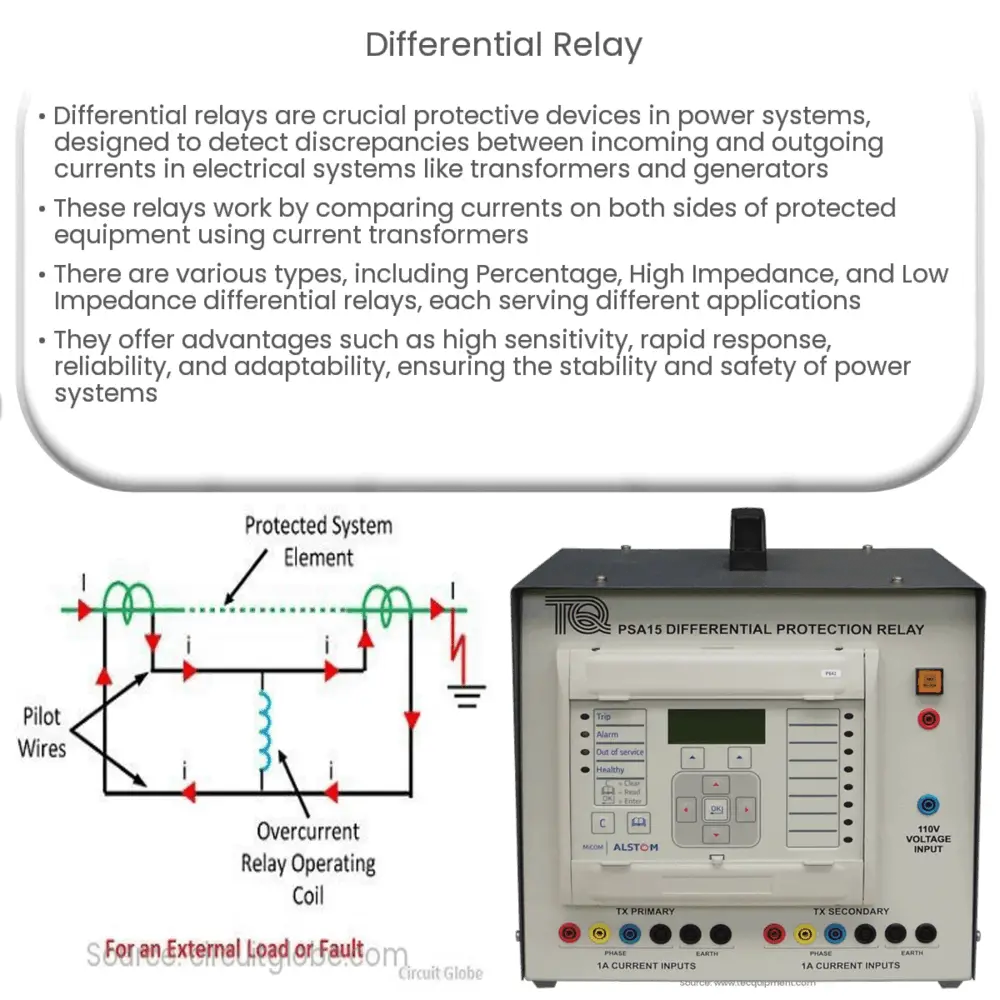A differential relay is a protective device that detects imbalances in incoming and outgoing currents, safeguarding transformers, generators, motors, and busbars.

Differential Relay: An Essential Protection Device in Power Systems
Introduction
A differential relay is a vital protective device used in power systems to prevent electrical faults and ensure the safe operation of equipment. It is specifically designed to detect discrepancies between incoming and outgoing currents in electrical systems, such as transformers, generators, and motors. In this article, we will delve into the working principles, types, and applications of differential relays to provide a comprehensive understanding of their importance in safeguarding power systems.
Working Principle of Differential Relays
The primary function of a differential relay is to monitor the difference between incoming and outgoing currents in a protected system or equipment. Under normal operating conditions, the incoming and outgoing currents are balanced, and the difference is negligible. However, when a fault occurs, this balance is disrupted, leading to an imbalance in the currents. The differential relay detects this discrepancy and triggers a trip signal to isolate the faulty section, thereby preventing further damage to the equipment and ensuring the safety of the power system.
The basic principle of a differential relay is the comparison of two or more currents entering and leaving a particular section of a power system. This is achieved by connecting current transformers (CTs) on both sides of the protected equipment. The CTs convert the high currents in the system into low, proportional currents suitable for the relay’s operation. The relay then compares the incoming and outgoing currents to determine if there is a significant difference, indicating a fault. If a fault is detected, the relay sends a trip signal to the circuit breaker, which disconnects the faulty section from the power system.
Types of Differential Relays
There are several types of differential relays, each with its own unique features and applications. Some common types include:
- Percentage Differential Relay: This type of relay is designed to operate when the difference between the incoming and outgoing currents exceeds a predetermined percentage of the total current. It offers improved sensitivity and stability compared to other differential relays and is commonly used to protect transformers and generators.
- High Impedance Differential Relay: This relay operates based on the voltage developed across a high impedance connected in the relay’s operating coil. It is widely used in busbar protection schemes due to its simplicity, reliability, and cost-effectiveness.
- Low Impedance Differential Relay: In contrast to the high impedance differential relay, the low impedance differential relay operates based on the current difference between the incoming and outgoing currents. It is typically used in transformer protection schemes and offers faster operation and better sensitivity.
In the next section, we will discuss the applications and advantages of differential relays in various power system protection schemes.
Applications of Differential Relays
Differential relays play a crucial role in safeguarding power systems and are employed in various protection schemes. Some key applications include:
- Transformer Protection: Differential relays are widely used to protect transformers from internal faults such as winding short-circuits and ground faults. They help prevent catastrophic failures and extend the operational life of transformers.
- Generator Protection: Differential protection is essential for generators to detect stator winding faults and prevent extensive damage to the equipment. These relays are designed to provide fast and reliable protection for generator units.
- Motor Protection: Differential relays are also used to protect motors from internal faults, ensuring their safe and efficient operation. They help minimize downtime and reduce maintenance costs associated with motor failures.
- Busbar Protection: Busbars, which distribute power within a substation, are protected using high impedance differential relays. These relays can quickly isolate busbar faults, preventing widespread power outages and equipment damage.
Advantages of Differential Relays
There are several advantages to using differential relays in power system protection schemes, such as:
- High Sensitivity: Differential relays can detect even minor imbalances between incoming and outgoing currents, enabling them to identify faults quickly and accurately.
- Fast Operation: The rapid response of differential relays allows for the swift isolation of faulty sections, minimizing the impact on the overall power system and reducing the risk of equipment damage.
- Reliability: Differential relays are highly reliable in detecting internal faults and have a low likelihood of false tripping, ensuring the stability and safety of power systems.
- Flexibility: With various types of differential relays available, they can be tailored to meet the specific requirements of different power system components, such as transformers, generators, motors, and busbars.
Conclusion
Differential relays are indispensable protection devices in modern power systems. They provide essential safeguarding for critical equipment such as transformers, generators, motors, and busbars by detecting and isolating internal faults swiftly and accurately. With their high sensitivity, fast operation, reliability, and flexibility, differential relays contribute significantly to the overall stability and safety of power systems, ensuring uninterrupted power supply and reduced maintenance costs. As power systems continue to evolve and become more complex, the importance of differential relays in maintaining system integrity and reliability will only grow.

